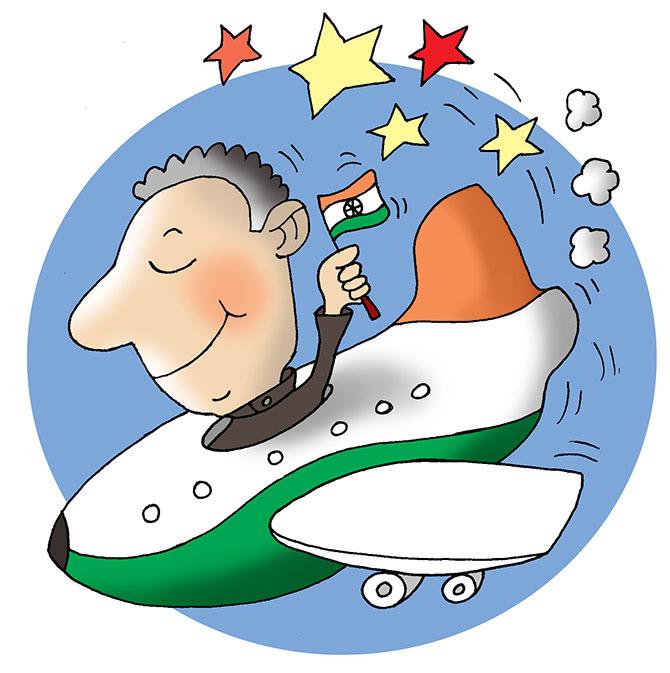Thanks to the flaws in the way it is implementing dynamic pricing, the Indian Railways is losing its premium travel base faster than ever before, say RailYatri's Manish Rathi and Kapil Raizada.
Illustration: Uttam Ghosh/Rediff.com

On December 20, Suraj Rastogi, a RailYatri user, went looking for a train ticket for a journey between Guwahati and Pune. The only option was a Suvidha train with 45 seats on AC III class. The price tag? Rs 6,590 for a 52-hour journey.
A three-hour flight option, for the same day, was available for Rs 4,790.
We at RailYatri -- based on our data analysis and traveller surveys -- now fear that the Indian Railways (IR) is losing its premium travel base faster than ever before. Much of the blame falls on the pricing schemes implemented in the last few years.
Historically, Shatabdi, Rajdhani and Duronto are among the premier trains, catering to travellers willing to pay for added comfort, reliability, and timeliness. These premier train passengers have already seen fares increase by nearly 70 per cent in the last few years (without taking dynamic pricing into consideration).
Our findings show that premier travellers understand the rationale behind dynamic pricing. The issue is with implementation.
We can't blame them, because the existing slab-pricing implementation is indifferent/not adaptable to the ground reality. It may be called dynamic pricing, but there is nothing dynamic in it. A good dynamic pricing implementation should encourage demand when it is needed and increase the value of the service when the demand is higher.
Dynamic pricing has made trains 15 per cent more expensive than airlines
The emerging rule is higher the class, lower the distance travelled.
Long distance (above 1,000 km) premium travellers are increasingly opting for air travel over trains. Even at the same costs, flights provide added advantages, with simpler booking processes, shorter travel hours, no wait-lists and lesser delays.
Our research indicates that 8-12 per cent of travellers migrated from trains with dynamic fares.
The percentage is similar to the number of wait-listed travellers. This implies these trains are now running at less than full capacity.
With January to March being a relatively lean season, the demand is expected to drop further.
Migration of the last-minute/mid-distance traveler
If flights are taking away premium long distance travellers, buses provide alternative options for distances less than 1,000 km.
The biggest selling proposition of bus travel is its near guaranteed supply. It is possible to walk to a counter and book a bus ticket for immediate travel. While the flat-bed sleeper bus replicates the train experience, the improvement of road networks has reduced travel time, too.
Wait-list in non-premium trains has increased
At least 48 trains ply between Kanpur and New Delhi. However, it is not unusual to see Shatabdi with 500 seats vacant even as all other trains have longer wait-lists. This shows the market is highly price-sensitive and some premium traffic has spilled over to other trains.
Unless addressed, the demand for subsidised classes will continue to increase.
This being the segment that is contributing to losses, the question remains about the Railway's ability to attract profitable customers.
Loss of pricing power
There is growing convergence of pricing across trains, buses and flights. For the first time in the Railways' history, fare determination is being driven by market forces.
The Railways is used to determining its own fares, but those days are coming to an end. Players who cannot work within market-determined pricing will be punished by consumers, who will simply stay away.
The way forward
We understand the need to serve budget travellers even if they contribute to losses. However, for economic viability it is equally important for IR to retain its once profitable loyal customer base.
Here are a few suggestions:
i) Overhaul dynamic fares -- pricing is science;
ii) IR needs to stop spreading itself thin. Selling secondary items such as rooms, taxis, etc while bleeding the customer base does not make sense;
iii) Revisit quotas. Quotas take away seats from the market and create uncertainty for the traveller, who then looks for other options.
Manish Rathi is CEO and co-founder, RailYatri.in. Kapil Raizada is co-founder, RailYatri.in.












 © 2025
© 2025